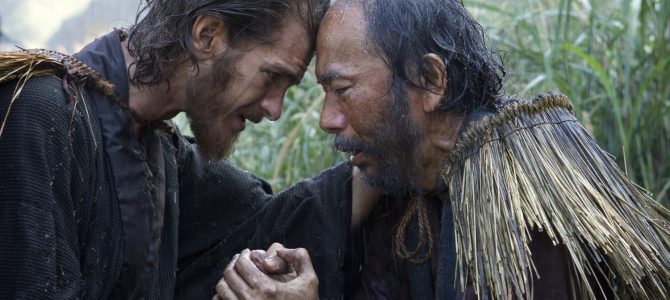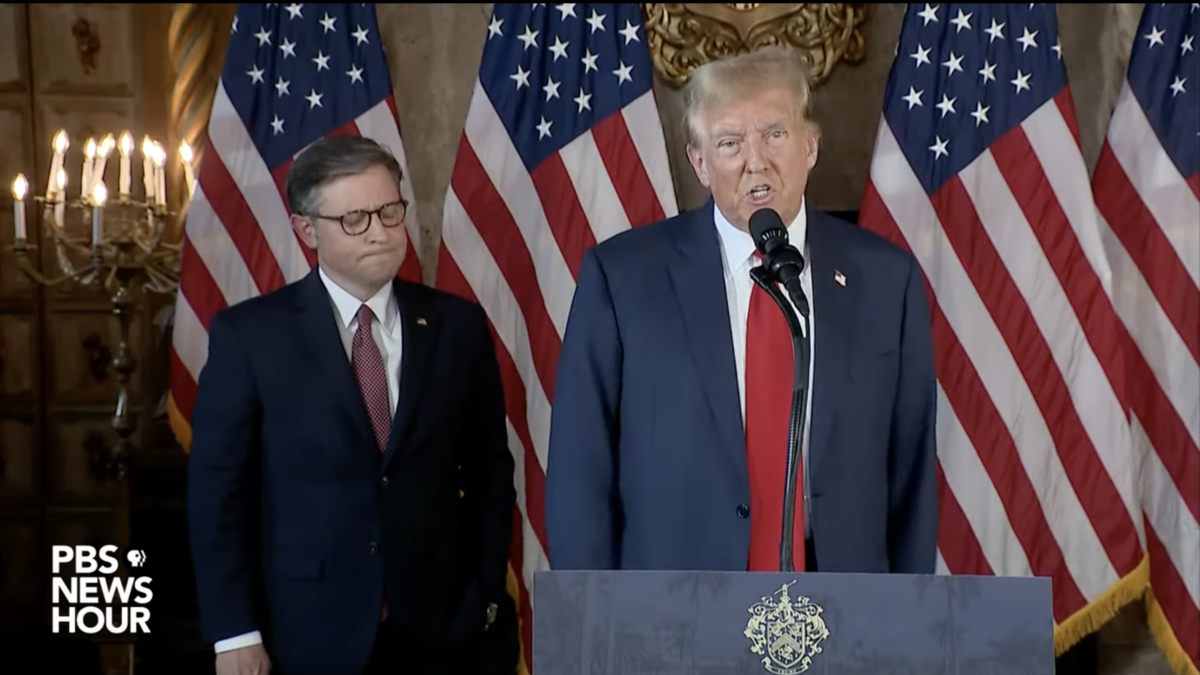
Martin Scorsese’s new film “Silence”—an adaptation of the 1966 novel by Shūsaku Endō—has already been winning plaudits from a broad diversity of film critics, and is almost certain to spark thoughtful reactions from viewers of faith. The story probes issues of culture, faith, courage, and value in ways that bite deeply—and is perhaps Hollywood’s most compelling portrayal of religious themes since “The Passion of the Christ.”
I read “Silence” over the Thanksgiving holiday this year, and it was without doubt the most powerful novel I read this year. The riveting drama continues to haunt me more than a month later, particularly after seeing the film. Set in Japan in 1639, “Silence” follows the journey of two Catholic priests—Father Rodrigues (Andrew Garfield in the film version) and Father Garrpe (played onscreen by Adam Driver) who are dispatched to discover the truth behind the alleged apostasy of senior priest Father Ferreira (Liam Neeson).
As the narrative unfolds, Rodrigues and Garrpe find themselves on a journey into darker and darker situations of torture and martyrdom. Human evil closes in around them. God remains perpetually silent, plunging Rodrigues into an agonizing “dark night of the soul.”
How Martin Scorsese Translates ‘Silence’ to the Screen
Scorsese brilliantly translates Endō’s novel to the screen: “Silence” is a long, but totally engrossing film that takes time to build up its devastating dramatic stakes. In part, this is a story of the persecuted church: an unflinching depiction of Japanese Christian martyrs who are blasted with scalding water, beheaded with swords, left to die in freezing waves, and burned alive at the stake. Yet Scorsese, despite his occasional penchant for over-the-top violence, never allows the imagery here to become exploitative—or, indeed, anything less than reverent.
In some ways, despite its depictions of heroism in the face of horror, “Silence” is also a painfully sobering study of human weakness. Perhaps the film’s most memorable character is the cringing Kichijiro (Yôsuke Kubozuka), a perpetual apostate who comes off as a combination of Judas and Gollum (and ultimately ends up betraying Father Rodrigues to the inquisitorial authorities). Over and over, Kichijiro claims to renounce his faith when put to the test… and over and over, Kichijiro comes crawling back to Rodrigues for absolution.
Though Scorsese never explicitly says so onscreen, one is left realizing that we are all Kichijiro. We humans may wish ourselves to be brave martyrs, standing up boldly against the flames, but we fail far simpler tests: when offered opportunities to sin against God and man, we endlessly do so, yet continually plead for grace. And that thought, in the face of a culture that ceaselessly urges celebration of self-serving desire, is a disquieting revelation indeed.
‘Silence’ Is Not an Epic Movie—It’s a Reverent Film
Most gratifyingly of all, Scorsese resists any temptation to make “Silence” an “epic movie” whose focus drifts from religious drama into other cross-cultural debates (i.e., is missionary work a form of imperial political control?). Instead, “Silence” is a lean, sparely made film that draws its power from its performances and themes (there’s virtually no music, a stylistic choice that exacerbates the movie’s grim reality).
But discussions of the film’s emotional weight and technical proficiency aside, the pivotal last act of “Silence” has already drawn the most debate. This is a film that cannot fully be understood apart from an understanding of the paradoxes of faith, and viewers not acquainted with the complexities of Christian doctrine might not appreciate Endō and Scorsese’s project as keenly.
(It’s virtually impossible to discuss the core themes of “Silence” without some spoilers, so if you’re determined to appreciate the novel or Scorsese’s film carte blanche, stop reading now.)
What the Film’s Climactic Scene Asks Us about Faith
In the climactic scene, Rodrigues is confronted with a terrible dilemma: if he places his foot upon a fumi-e (a bronze image of Christ), and in so doing symbolically renounces his faith, he and a group of local villagers will be spared. If he does not comply, the villagers will be slowly tortured to death. Everything hinges on Rodrigues’s choice.
In that instant of decision, Rodrigues—after months of begging for divine explanations and answers—hears the voice of God for the first time, speaking from the fumi-e:
And then the Christ in bronze speaks to the priest: “Trample! Trample! . . . It was to be trampled on by men that I was born into this world. It was to share men’s pain that I carried my cross.”
Rodrigues steps on the fumi-e, and immediately a cock—like the one that reminded the Apostle Peter of his betrayal of Christ—crows. The decision is deeply momentous, but its full significance only becomes clear upon reflection.
Is ‘Silence’ a Study of Moral Weakness?
The most straightforward interpretation of “Silence” is that it is a study of moral weakness. Despite repeatedly urging himself not to emulate Ferreira by abandoning principle in extremis, Rodrigues succumbs in the end… and the remainder of his life in Japan becomes a painfully desperate attempt to rehabilitate himself in the eyes of God. An article from The Gospel Coalition summarizes the message of “Silence” as the idea that “even in our failures and silence, God still speaks.”
While such a view is perhaps unsurprising given the general Reformed rejection of sacramental theology, I would venture that this is too superficial a reading of “Silence,” and one that downplays the theological drama of Rodrigues’s central choice.
In placing his foot on the fumi-e, Rodrigues sacrifices that which is most dear to him—his identity as a priest and representative of God—to redeem those who are suffering. The consequences of his act—which will include a “blacklisting” by the Church, and the specter of a perceived failure vis-à-vis the martyrs of old—become, in a way, his own cross to bear. The question is much more challenging than one of mere personal weakness. In committing an act that appears to be a renunciation of faith—a renunciation of that which is most dear to him, because Christ Himself asked it of him—is Rodrigues participating in Christ’s sacrificial death more intimately than ever before?
The Paradox of Sacramental Theology
Put another way, the Christian concept of kenosis—a self-emptying, a voluntary sacrifice of some of His essential characteristics —explores the ways in which Jesus divested himself of aspects of His divine nature in order to take on human nature. By similarly emptying himself of that which he believed to be essential to his salvation (his steadfast refusal to “succumb” to the enemy) in order to save the lives of others, is Rodrigues “dying with Christ” (Romans 6:8) in a hitherto-unprecedented way?
That is the real question that “Silence” asks, and it cuts readers and viewers to the quick.
How, then, to think of Rodrigues’s dilemma? While Endō’s story resists a single easy answer, traditional Japanese religious literature and the historic Christian tradition both offer glimmers of interpretive insight.
Zen Buddhist philosophy relies on kōans—often-cryptic parables that force the reader to step outside the framework of Western analytic philosophy. One such kōan, reproduced in Douglas Hofstadter’s book “Gödel, Escher, Bach: An Eternal Golden Braid,” sheds light on Rodrigues’s conflicting obligations:
Shuzan held out his short staff and said “If you call this a short staff, you oppose its reality. If you do not call it a short staff, you ignore the fact. Now what do you wish to call this?”
On its face, this kōan might appear incomprehensible—a shaggy-dog story with no discernible point. A closer look, however reveals the point of the parable. The “short staff” in question may also be described as a “piece of wood,” a “branch from the oak tree beside the chapel,” “a work crafted by the master next door,” and countless other things. All these descriptions are true statements about the short staff; the description “short staff” alone does not capture the totality of properties of the item in question.
The imperfect relationship between language and reality produces a paradox: the “short staff” may be correctly identified as such, but calling it a “short staff” implicitly excludes other descriptors that may be assigned to it.
Rodrigues’s Dilemma Is Full of Moral Paradox
This type of paradox is bound up in the sacramental theologies that teach a correspondence between physical elements (water, bread, and wine) and the regenerating grace of God or the Body and Blood of Christ. Describing the wafers of Holy Communion as simply “bread” is, as the Zen kōan’s Shuzan would put it, a way of “opposing their reality.”
Additionally, failing to recognize that material elements also exist in the sacraments “ignores their fact.” The doctrine of the Incarnation—the belief that the transcendent God of the universe, the Ground of Being, took on the form and nature of a human infant—also rests on a paradox of this sort. (Christmas itself is a celebration of this paradox!) So too does the doctrine of the Trinity itself: the belief that God exists in three Persons, but one essential union.
The moral stakes of Rodrigues’s decision to step on the fumi-e—to either renounce his faith before men, or to more fully participate in the suffering of Christ—are only truly grasped by understanding the intractability of such philosophical paradoxes within both the Christian and Japanese traditions. The average Western mind (including mine) wants desperately to classify Rodrigues’s action as self-sacrificial or as craven apostasy, but Endō defies this easy binary. Maybe, in a way, both of these things are true. (Scorsese makes this tension more explicit onscreen than Endō does in the novel.)
To its enduring credit, “Silence” does not answer the questions it poses: they are by nature unanswerable. It deserves acclaim for having the audacity to ask those questions—to probe the essential paradox of “dying with Christ” in ways most Westerners find difficult to countenance.
(Spoilers end here)
‘Silence’ Is a Must-See Masterpiece
In short, “Silence” is a masterpiece that demands to be seen. This is a movie that manages to be powerfully inspirational without the faintest trace of crass sentimentalism: Scorsese has crafted one of the most deeply Christian films in years, translating the rich themes of Endō’s book to screen without dilution.
As far as future religious dramas are concerned, “Silence” decisively sets a new benchmark.









